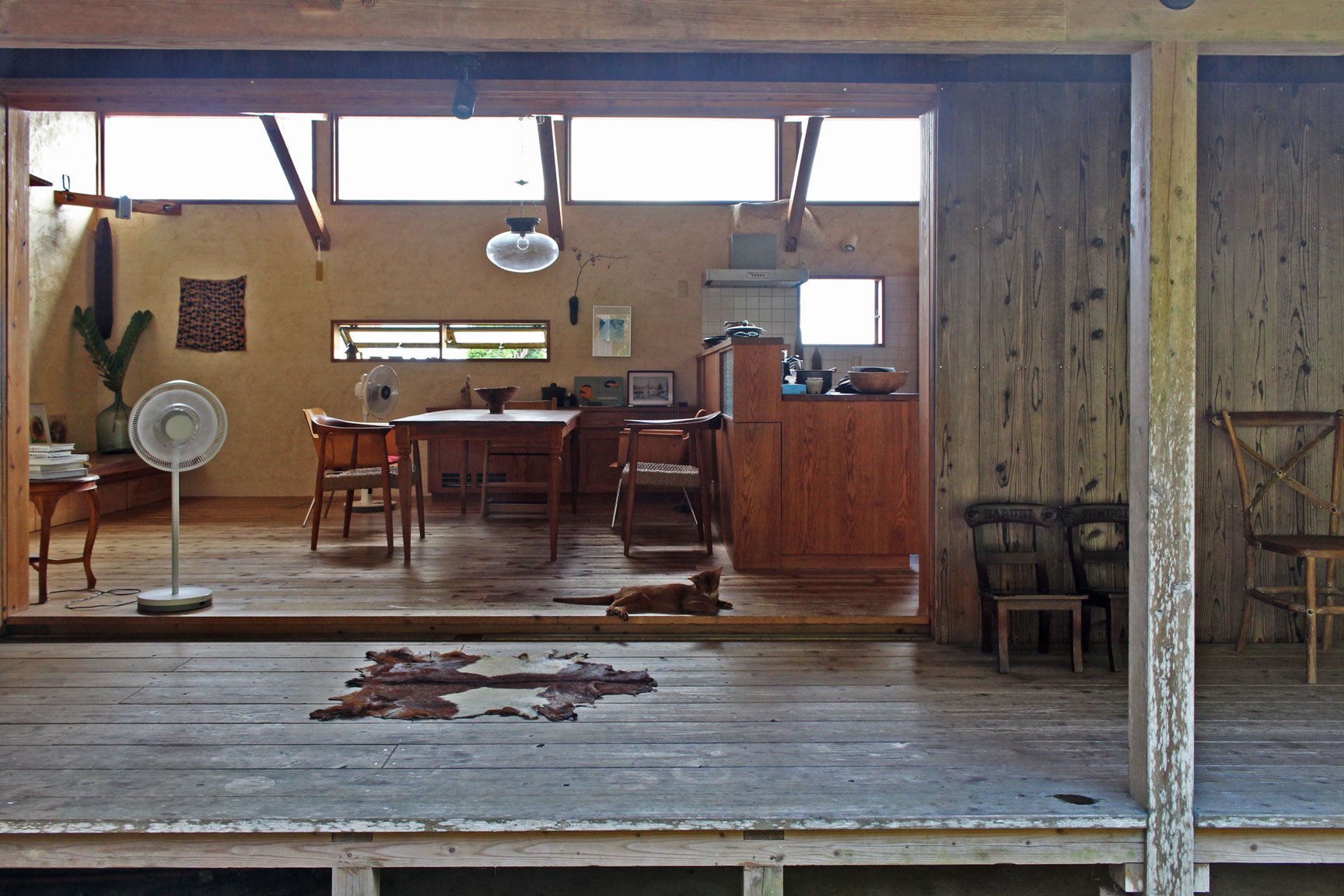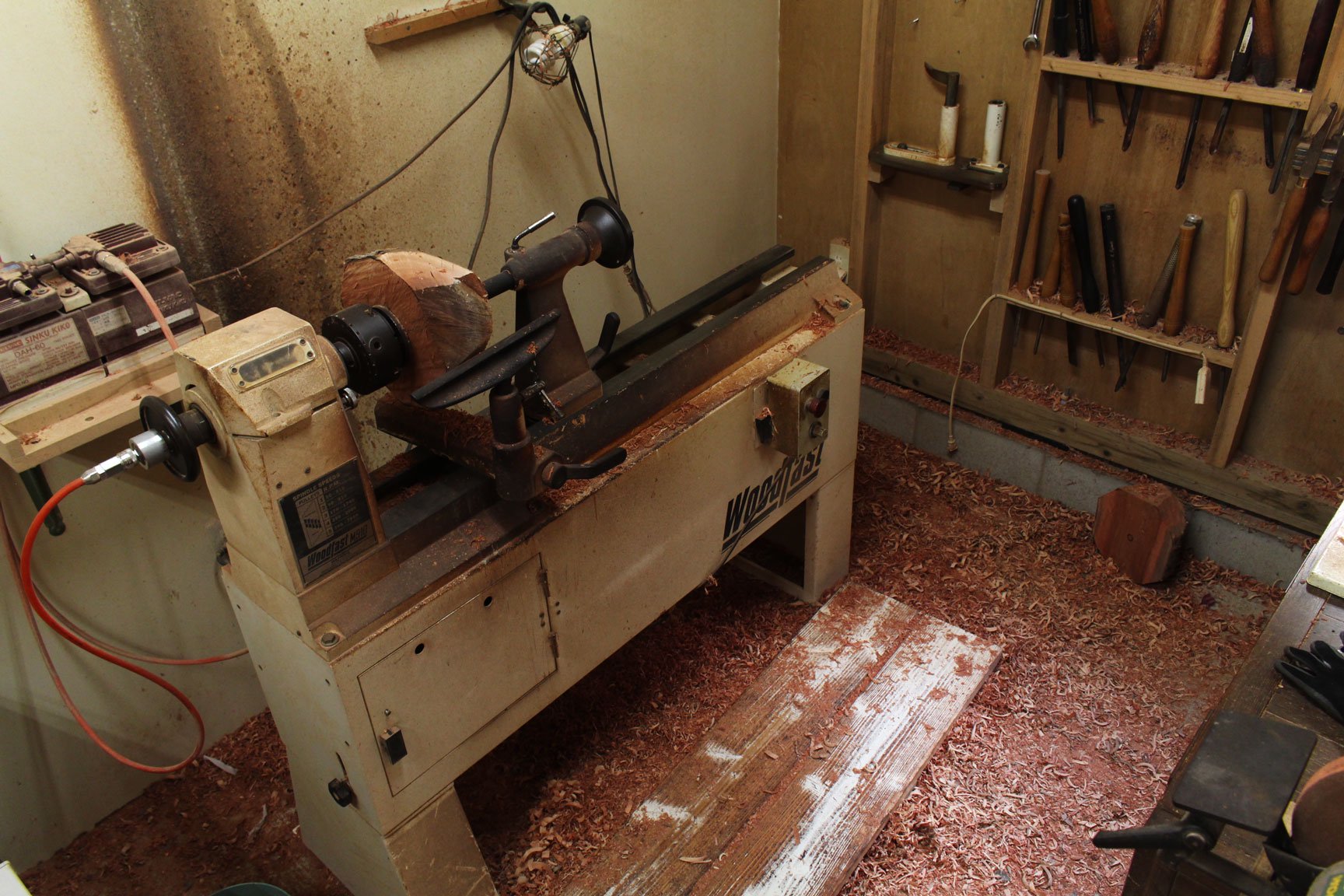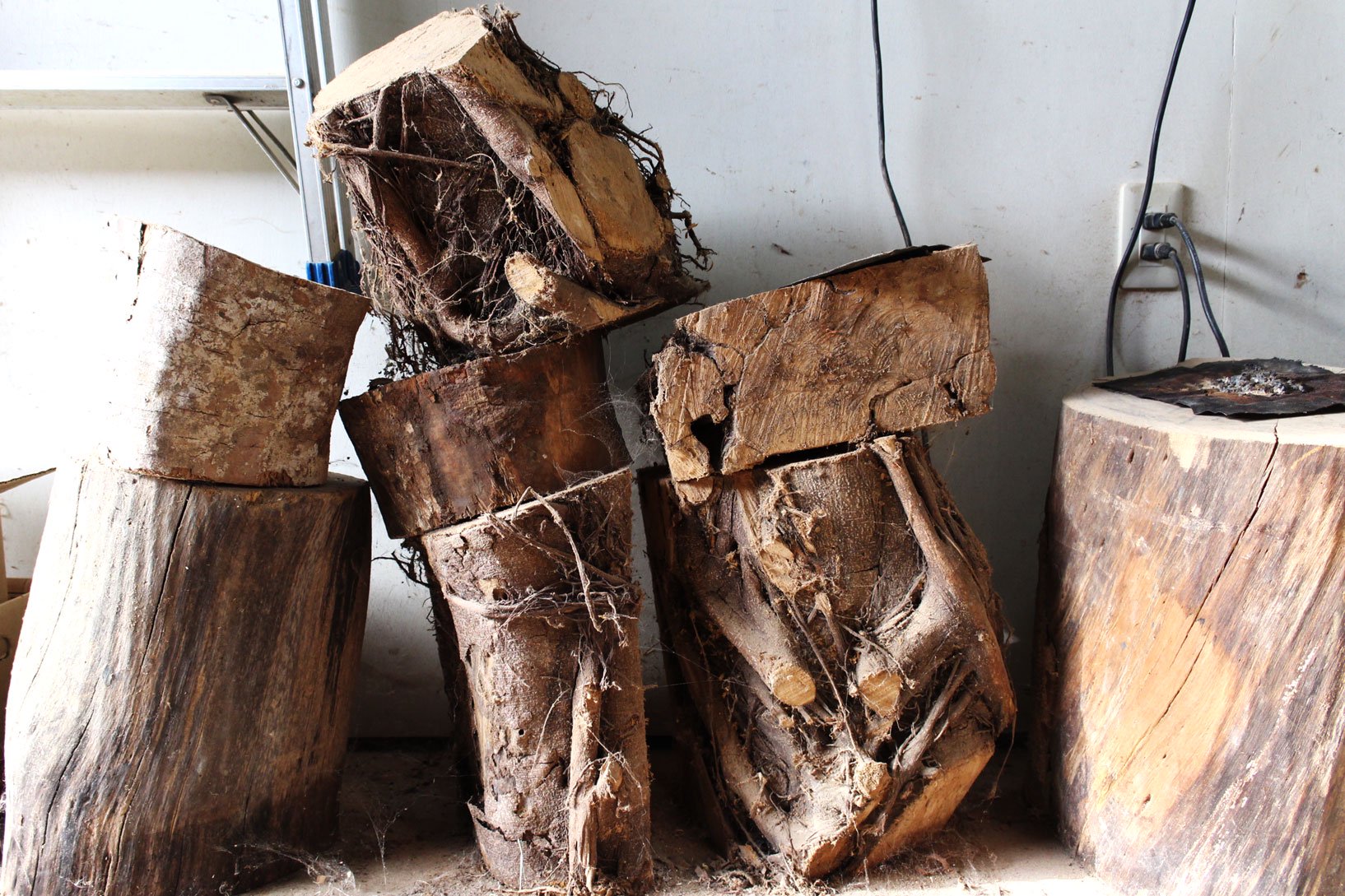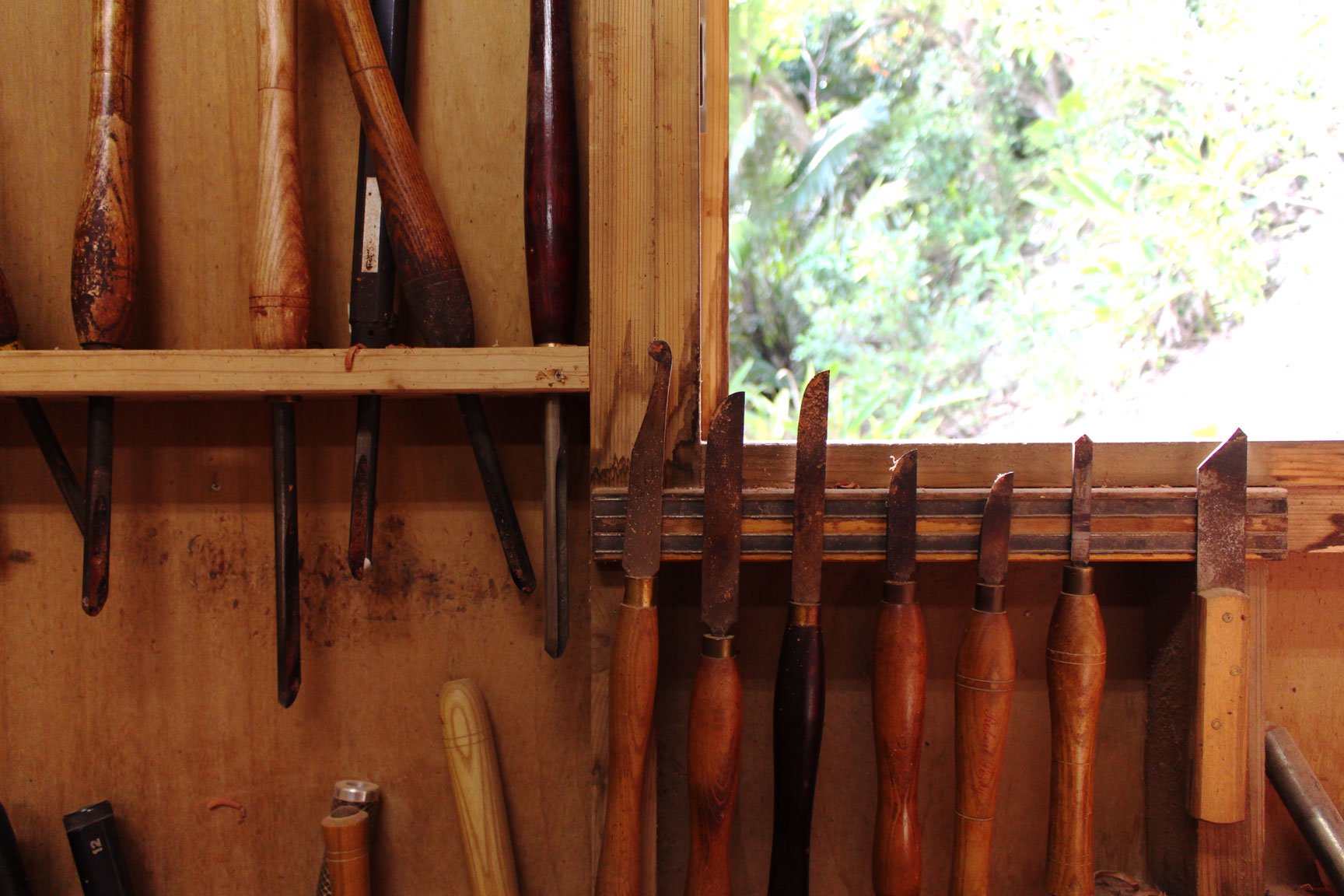沖縄本島の南部に位置する南城市、海を臨む小高い丘のふもと、緑豊かな土地に藤本健のアトリエはある。敷地内に建てられた自宅、作業場、ギャラリー、知人の運営するレストラン、すべてが彼自身の設計・施工によるものだ。木造平屋の自宅は、中庭に向かって大きく開口したリビングから縁側がせり出し、内と外とがひと続きであるかのような、開放感のある造りになっている。一方、裏山に沿って建てられたギャラリーは、漆喰の白壁でできた6畳ほどの秘密基地のような箱だ。焼杉の壁で囲われたレストランでは、藤本の木の器で料理がふるまわれる。自身が手がけた空間で、生活し、作品をつくり、その作品が人の目に触れ、人の手に渡っていく、まさにここは藤本の作家人生が循環する場所だといえる。
Ken Fujimoto 藤本健
使い手に解釈を問う、余白を残した木のうつわ

作品の生まれる場所

家具職人から木工作家へ
最初から最後まで、すべて自分一人で完結できる、そんなものづくりを仕事にしたい。そう考えた藤本は、世の中でインテリアや家具が脚光を浴び始めていた時代、自然と家具職人の道を志す。木工を一から学び、東京の会社で数年間、特注家具をつくる職人として働いた。その後、沖縄への移住を機に独立。ある時、興味本位で使ってみた木工旋盤(木材を回転させるろくろのような機械)が意外にも自分にフィットし、受注家具の制作と並行して器づくりをスタート。受注を受けて、寸法通り完璧に作ることが求められる家具づくりと、形も大きさも自分が決めて自由につくる器づくり。相反する仕事を並行しながら、徐々にクリエーティブな器づくりに傾倒していった。

常識ではありえない器
藤本の作品は、器の常識ではありえない、歪みや割れや穴を敢えて個性として残している。通常の流通では廃棄処分される木材を使い、水分を含んだ生木の状態から削って器の形にする。そこから乾燥させることで木の収縮が発生し、自然な歪みや割れが生まれる。素材は、ホルトノキ、アカギ、ガジュマル、リュウキュウエノキなど、現地で手に入りやすい木材を使う。それらを旋盤で荒削りしていきながら、その大きさ、形から何ができるかを考える。作り続ける中でどんどんタガが外れていった、と語る藤本は、大きく歪んだり、穴が開いていたりと、より普通ではないカタチを追求するようになった。当然、自然の変形をコントロールすることはできないが、個性的な形が生まれるよう、敢えていびつな部分を残して成形するのだという。人の手と、木の自発的な作用があいまって生まれるカタチは、木の抑制されない、嬉々とした表情を感じさせてくれる。

自分がつくる意味
木工作家になって、今のスタイルで器をつくるようになったのは、実は自然な流れだったという。誰もいない土俵で、誰もやらないことをやる。家具づくりからシフトしたのも、家具なら他に作れる人間がいくらでもいる、と感じたからだった。穴が開いた木の器をつくる人間は、他にいない。だからこそ、そこに自分がつくる意味を感じられた。自分の作品は、穴が開いていて、割れていて、器としては使い勝手の良いものではないかもしれない。それでも見立て方によって、オブジェにも、花器にもなる。使う人次第で様々な価値を見出されるモノ、そうした余白のある作品を作りたい、という。使い方を規定されない作品は、その分、使う側の解釈や想像力を試される。アートとも器とも括られない、唯一無二の藤本の作品は、向き合い方次第で様々な世界を見せてくれる。

- 1971
- 愛知県生まれ
- 2002
- 東京生活を経て、沖縄移住
- 2011
- 器を作り始める
以降個展等を中心に活動
常設店舗 call、雨晴(東京)、HS(大阪)、sahan(名古屋)、GARB DOMINGO(沖縄)など
Wooden tableware with some space for you to fill in

Where the artwork is made
Ken’s atelier is located by the hill with greenery facing the ocean in Nanjo-city in the southern part of Okinawa mainland. All on the property was designed and built by Ken, his house, atelier, gallery, and restaurant which his friend runs. His one-story wooden house with a wide opening living room towards the inner courtyard gives the impression of such openness as if there were no divider of the inside and the outside. By contrast, his gallery by the mountain behind is like a secret base built with white plaster walls and only a studio size. The restaurant is surrounded by the traditional Japanese burnt wood walls, and the food is served on Ken’s wooden tableware. Living and creating in the environment he created, presenting his artworks, and handing them to people; this is exactly where his life as an artist flows.

From a furniture craftsman to a woodworker
Wanting to complete from the beginning to the end all by himself, Ken desired such art process as his work. When the interior designs and furniture was the trend, he innately began his career as a furniture craftsman. He learned woodwork from scratch and crafted custom order furniture at a company in Tokyo for a few years. Later he relocated to Okinawa and started on his own. One day, he used a wooden wheel, like a pottery wheel out of curiosity, and this surprisingly suited him. This is how he began creating tableware alongside custom order furniture. Custom orders must be created exactly how it was ordered, and creating tableware was entirely up to him, size and shape. He continued these contradicting processes, and he began leaning towards the creative process of making tableware.

Unorthodox tableware
Ken’s artworks are exceptional and contain uneven deformation, cracks, and holes as its uniqueness. He uses wood that is usually thrown away and carves rare wood which water is still absorbed into tableware. Drying makes the wood shrink and forms natural unevenness and cracks. He uses materials which he can acquire locally; Elaeocarpus sylvestris, Bischof javanica, Ficus retusa, and Celtis boninensis. He roughly outlines them on the wheel, planning the size and shape. "Continuous producing became unrestrained,” he says. He began to seek for unordinary forms such as big deformation and holes. Obviously, he cannot control the natural form, but to produce unique shapes he purposely leaves deformed parts. The shape created by the mixture of human hand and wooden nature form presents its uncontrollable character and gives you a merry feeling.

The meaning of his creation
Ken says that it was very natural for him to become a woodworker and create tableware in the current style. Do it in where no one is and do what no one does. He shifted from furniture craft because he thought there are many who can create furniture. No one creates bowls with a hole. This is how he saw the reason for his creation. His artwork has a hole and cracked and may not be the handiest tool. However, it could be a decorative art or a vase viewing from a different angle. He says that he wants to create art pieces with some space for the user to fill in, pieces which its value is defined by its user. These artworks with no fixed purpose or guideline for usage test your interpretation and imagination. An artwork or tableware, Ken’s unique work provides various concepts depending on how you face them.

- 1971
- Born in Aichi, Japan
- 2002
- After living in Tokyo, moved to Okinawa
- 2011
- Started making wooden tableware
Showcasing works mainly at solo exhibitions
Stocked at call, Amahare (Tokyo), HS (Osaka), sahan (Nagoya), GARB DOMINGO (Okinawa) etc.
-

GAJUMARU #16
-

GAJUMARU #15
-

GAJUMARU #14
-

GAJUMARU #10
-

SABI URUSHI PLATE S/WHITE
-

SABI URUSHI PLATE S/BLACK
-

SABI URUSHI PLATE L/WHITE
-

SABI URUSHI PLATE L/BLACK
-

SABI URUSHI PLATE MEDIUM
-

SABI URUSHI PLATE LARGE
-

SABI URUSHI BOWL
-

URUSHI PLATE J
-

URUSHI PLATE I
-

URUSHI PLATE H
-

URUSHI PLATE G
-

URUSHI PLATE F
-

URUSHI PLATE E
-

URUSHI PLATE D
-

URUSHI PLATE C
-

URUSHI PLATE B
-

URUSHI PLATE A
-

HORUTONOKI BOWL
-

CHAAGI BOWL
-

AKAGI BOWL J
